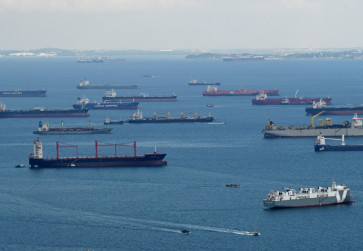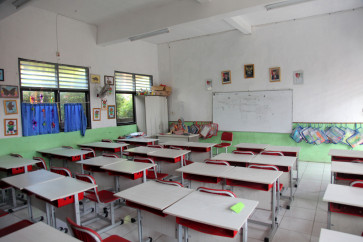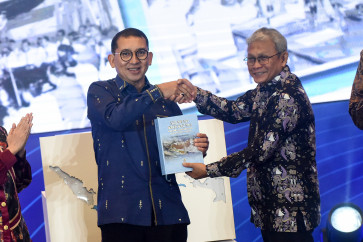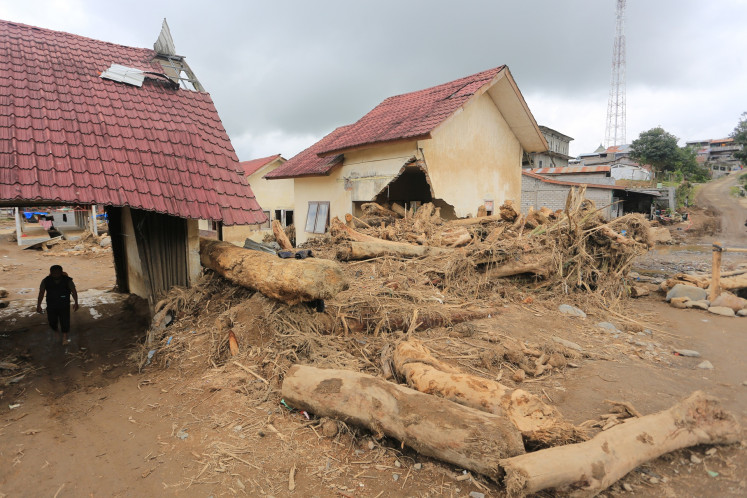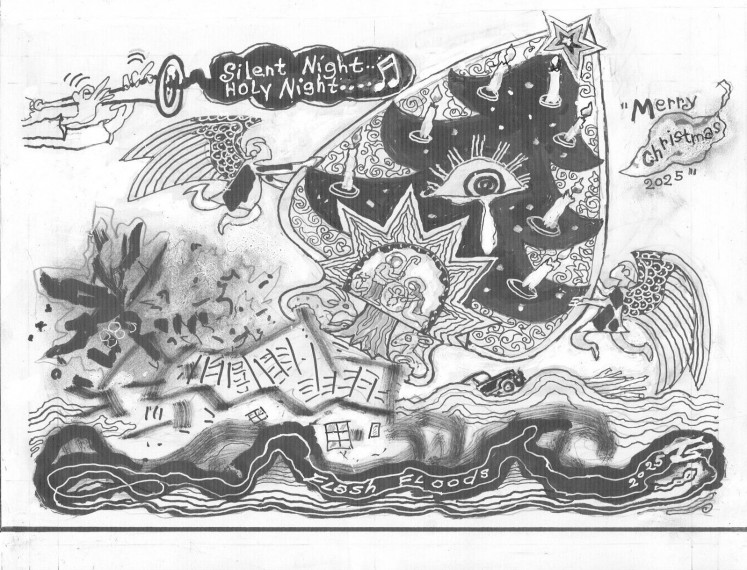Popular Reads
Top Results
Can't find what you're looking for?
View all search resultsPopular Reads
Top Results
Can't find what you're looking for?
View all search resultsPrice, style more important for Indonesia’s consumers than sustainable fashion
In stitches: A worker puts the finishing touches on a large tapestry made from scrap fabrics at the Threadapeutic warehouse in West Jakarta
Change text size
Gift Premium Articles
to Anyone
I
span class="caption">In stitches: A worker puts the finishing touches on a large tapestry made from scrap fabrics at the Threadapeutic warehouse in West Jakarta.(Courtesy of Threadapeutic)
As the public becomes more aware about the effects of plastics and other pollutants to the environment, more and more people have vowed to turn their lives around by using stainless steel straws, reusable food trays and even looking into buying electric vehicles.
However, it seems as if the same kind of awareness on sustainability has yet to reach the fashion world, as most consumers are more concerned about price points and style than whether the production materials and the overall manufacturing and distribution processes are sustainable.
“Many of [the customers] are more concerned about the comfort, style and price of the clothes instead of the materials,” Caroline Siahaan, designer and founder of local clothing line Oline Workrobe, said during a forum with the Indonesian Chamber of Commerce and Industry (Kadin) in Jakarta on Sept. 2.
This has led to low demand from customers for sustainable fashion products, she added.
Most fast-fashion products end up in landfills due to their short lifespan as these retailers produce clothes at high volumes using low-quality materials and sell them at low prices.
The fashion industry generated 92 million tons of trash, equivalent to 4 percent of the world’s waste each year, according to the 2018 Pulse of the Fashion Industry report.
Materials for sustainable fashion, Caroline said, usually last longer but also had higher production costs. Therefore, the clothes that use these materials tend to be more expensive than those that are less eco-friendly, she explained.
More affordable clothes have led to consumers discarding massive amounts of fast-fashion products. The United States-based used apparel collection company, World Wear Project, estimates that one person throws away an average of 32 kilograms of used clothing annually.
FX Afat Adinata, president director of fashion retailer PT Mega Perintis, which manages men’s clothing store Manzone, said that most of his customers could not tell the difference between various kinds of fabrics; what mattered most to them was that their clothes were fashionable and affordable.
This attitude has in turn affected producers, whose only concern now is to meet consumer demand rather than worry about where the garments come from and adhering to sustainability principles in the process.
The US$1.3 trillion global fashion industry emits 1.2 billion tons of carbon dioxide yearly and contributes to 20 percent of industrial wastewater pollution worldwide from the dyeing and treatment process, according to the Ellen MacArthur Foundation.
While the bigger players find it difficult to find the economies of scale to manufacture sustainable fashion products, smaller players find sustainability in fashion to be an agenda worth fighting for. Their methods include the upcycling of wasted textiles and using natural dye for coloring.
These small-to-medium industries target premium market buyers who have grown more conscious about environmentally friendly products and are willing to pay relatively higher prices to embrace the craftmanship and longer production time.
"It is therapeutic for me to know that we are able to turn something undesirable into something that is aesthetically pleasing and highly valued," fabric producer Threadapeutic’s designer, Nagawati "Hana" Surya, told The Jakarta Post.
Established in 2015, Threadapeutic has been upcycling scrap fabrics into fashion and interior items through fabric manipulation techniques to create textures. Its warehouse uses up to 30 kg of surplus cloth from factories, fashion houses and interior studios every month.
On average, about 70 percent of the clothes people own will end up in landfills, with only a quarter recycled, according to the 2018 Pulse of the Fashion Industry report.
“Our market comprises people who like artisanal work and who care about environmental sustainability. So, they understand the product’s quality and the message we want to convey,” Hana said. Threadapeutic sells bags and tapestries costing from Rp 1.5 million ($106) to Rp 3 million to local customers and foreigners, as it opens pop-up stores overseas, including in Singapore.
Meanwhile, Bali-based fashion boutique Canaan has been producing locally made clothes, scarves, as well as candles and ceramics using natural dye since 2016. The boutique’s founder, Emmelyn Gunawan, said only natural dyes made from leaves, petals and roots were used.
“Coloring using natural dyes takes longer since we have to soak, dry and repeat the process several times to get the shade we desire," she told the Post over the phone. After the colored textiles were ready, she said her team stitched and embroidered the products by hand.
“Most of our customers are tourists or foreigners. They are willing to pay a premium price for local craftsmanship and they are also aware of the importance of sustainability,” Emmelyn said, adding that she wanted Canaan to remain a medium-scale business to maintain sustainability.
In mainstreaming the "green fashion" movement, Climate Reality Indonesia project manager Amanda Katili Niode said the country still had a long way to go to fulfill the circular fashion economy. However, producers can take small steps such as using nonhazardous chemicals, natural dyes, as well as using less packaging and plastic.
“Most fashion industry players say the circular economy is still in the pilot phase, so we have yet to implement the full circular model,” she said at the Indonesian Circular Economic Forum on Nov. 11.
Although designers and retailers now have greater access to affordable, eco-friendly products, Kadin deputy chairwoman Shinta Kamdani said more needed to be done in promoting sustainable fashion in the country.
Aside from educating the public about the importance of sustainable fashion, she said, the upstream and downstream industries needed to be integrated to foster collective awareness among producers.
“The government could give fiscal incentives, while banks could offer lower interest rates for businesses known to use ethical materials for their products,” she said, adding that such efforts could reduce production costs and ensure the products remain affordable.
Industry Ministry secretary-general Achmad Sigit Dwiwahjono said the ministry was committed to tackling the textile industry’s hurdles, including by opening up more investment opportunities to reduce the industry’s reliance on imports.


